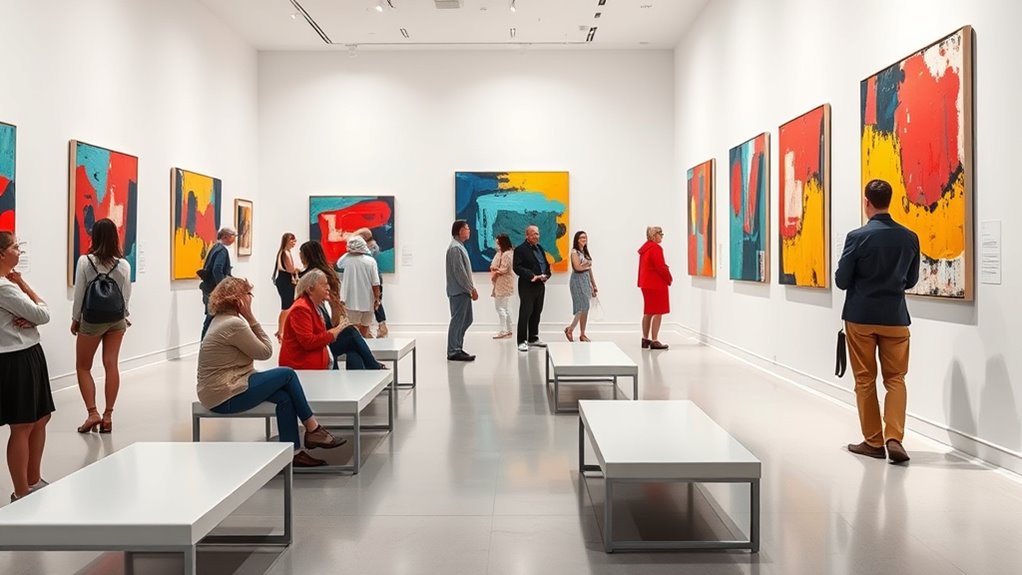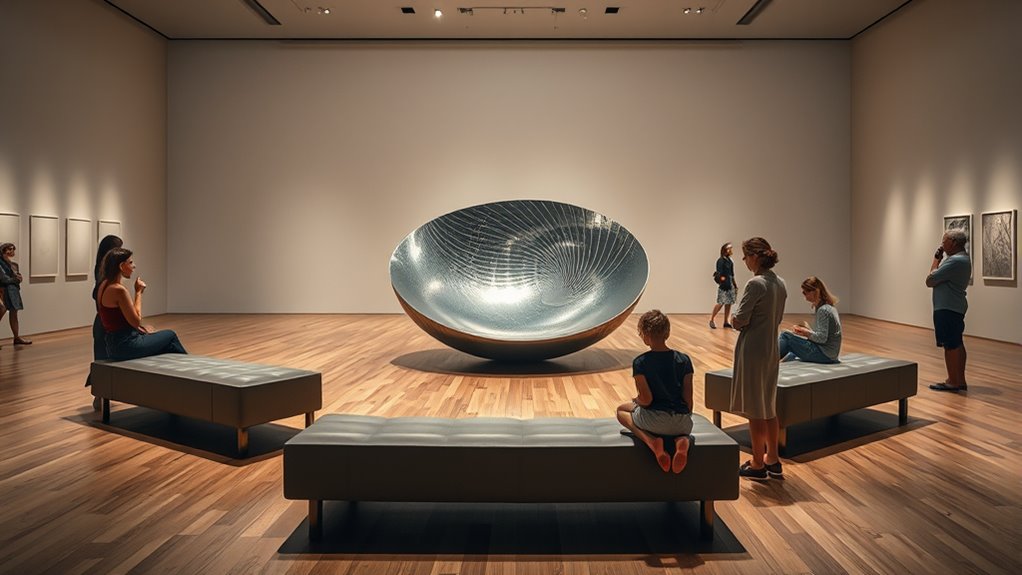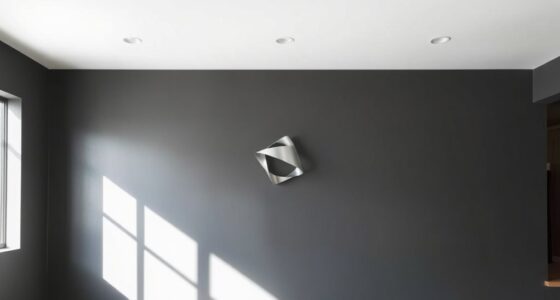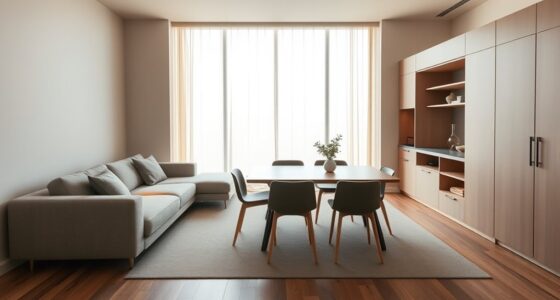To optimize art placement for both seated and standing viewers, position larger pieces on expansive walls at eye level (57-60 inches), while smaller works should be closer to eye level (48-52 inches) when seated. Consider the furniture height and room layout to make viewing comfortable from all angles. Proper placement balances aesthetics and functionality, ensuring everyone can enjoy the artwork effortlessly. If you want to learn more about perfecting your art arrangement, keep exploring these key tips.
Key Takeaways
- Hang art at eye level (57-60 inches) for standing viewers, ensuring natural engagement.
- Position art slightly lower (48-52 inches) for seated viewers to match eye level when seated.
- Adjust placement based on furniture height for comfortable viewing from both standing and seated positions.
- Use larger artwork on expansive walls for distant viewing; smaller pieces should be placed for close-up appreciation.
- Consider room layout and viewer posture to optimize art placement, creating an immersive and comfortable experience.

Have you ever wondered how the placement of artwork influences your viewing experience? The way art is positioned can dramatically change how you perceive and connect with it. When you walk into a space, your attention naturally gravitates toward certain areas, and the height, distance, and overall placement of art determine how easily you can engage with it. Whether you’re seated or standing, understanding these principles helps you appreciate art more deeply and guarantees it enhances your environment effectively.
If you’re standing, you typically view artwork best when it’s at eye level. For most adults, this means hanging the center of the piece about 57 to 60 inches from the floor. This height aligns with your natural line of sight, so you don’t strain your neck or have to look up or down excessively. When you position art too high, it can feel disconnected or intrusive; too low, and it might be overlooked or feel awkward. Keep in mind that the placement can vary depending on the ceiling height and the furniture surrounding the artwork. For example, if art is near a sofa or a chair, it should be at a height that complements the seating, allowing you to comfortably view it without craning your neck or tilting your head.
When you’re seated, your viewing experience shifts. You tend to look slightly downward or straight ahead, so placing artwork slightly lower than eye level when viewed from a seated position can create a more natural viewing angle. For example, if you’re decorating a sitting area or a waiting room, position pieces so that they’re within a comfortable eye range from your seated position—usually around 48 to 52 inches from the floor. This ensures that the art is not only visible but also engaging without requiring you to lean forward or strain your neck. Additionally, considering visual accessibility can make your space more inclusive for all viewers.
Distance also plays an essential role. When you stand, you can comfortably view larger pieces from a distance, so bigger artwork works well on expansive walls. Conversely, smaller works benefit from being closer, where details can be appreciated. When you’re seated, keep in mind that your viewing distance is usually shorter, so smaller pieces should be placed where they can be seen clearly without squinting or leaning in.
Ultimately, thoughtful placement considers your typical viewing position—standing or sitting—and adapts accordingly. When you pay attention to height, distance, and surrounding furniture, your experience with art becomes more immersive and satisfying. Proper placement doesn’t just make art look better; it invites you to connect with it more meaningfully, whether you’re standing at an exhibit or relaxing in your favorite chair.
Frequently Asked Questions
How Does Lighting Affect Art Visibility for Seated Versus Standing Viewers?
Lighting plays a vital role in how you see art, whether you’re seated or standing. If the lighting is too harsh or uneven, it can create glare or shadows that obscure details, especially for seated viewers closer to the artwork. Properly positioned, adjustable lighting ensures even brightness, highlights key features, and reduces glare, making the art more visible and enjoyable for everyone, regardless of their viewing position.
What Are the Best Heights for Installing Artwork in Different Spaces?
You should install artwork at eye level, typically 57 to 60 inches from the floor to the center of the piece, to guarantee ideal visibility. In spaces with seated viewers, consider lowering the art slightly so it remains comfortably viewable from a seated position. For high-traffic areas or galleries, adjust heights to accommodate viewing angles and lighting, ensuring the artwork is easily appreciated from various distances and positions.
How Can Artwork Be Arranged to Accommodate Viewers With Disabilities?
Imagine a gallery where everyone feels included. You can achieve this by placing artwork at varying heights—some at eye level for standing viewers, others lower for wheelchair users or seated visitors. Use tactile, audio, or braille descriptions alongside visual art to enhance accessibility. Keep pathways wide and clear, ensuring all visitors can comfortably approach and enjoy the pieces. Your thoughtful arrangement makes art accessible, welcoming, and engaging for everyone.
How Does Wall Color Influence the Perception of Artwork Placement?
Wall color markedly influences how you perceive artwork placement. Bright or bold colors can make artwork stand out and draw attention, while neutral tones create a calm backdrop that highlights details without distraction. You should consider contrast when hanging art; a darker wall enhances lighter pieces, and vice versa. By choosing wall colors thoughtfully, you can guide viewers’ focus and create a harmonious, engaging display that complements your artwork’s style and mood.
What Considerations Are There for Outdoor Versus Indoor Art Placement?
You’ve got to think outside the box when placing outdoor versus indoor art. For outdoor, consider weather, natural light, and durability, making sure your piece can stand the test of time. Indoors, focus on lighting, wall space, and viewer proximity. It’s like comparing apples and oranges—each setting demands unique tweaks to make sure your art truly shines and resonates with viewers.
Conclusion
Whether you’re designing for seated or standing viewers, remember that thoughtful placement creates connection, guides attention, and enhances experience. Consider eye level, sight lines, and accessibility to guarantee your art resonates. Respect the space, engage the viewer, and balance visibility with harmony. By paying attention to placement, you invite viewers to pause, reflect, and appreciate. Ultimately, good art placement transforms spaces, invites interaction, and makes every view memorable, no matter how your audience is positioned.









